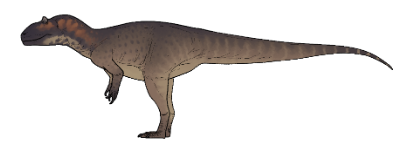Utah has a rich paleontological history and in-depth fossil records with new discoveries being made every day. Due to Utah’s wealth of fossils, it is one of the only states with both a state dinosaur and a state fossil. While they sound similar they are not the same thing, a state dinosaur must be a dinosaur and a state fossil can be a dinosaur or any other prehistoric animal that is significant to that state like a trilobite.
Utah’s state fossil is the allosaurus, with more allosaurus fossils being found in Utah than any other place on earth it is a natural choice. The Allosaurus was an imposing carnivore and apex predator terrorizing the United States over 145 million years ago. In the Theropod family the allosaurus looked similar to the tyrannosaurus rex but lived around 60 million years earlier, it also had longer forearms to hold struggling prey and was not actually closely related to the t-rex. The name allosaurus means “strange lizard” derived from Greek, it was named this due to its unique Vertebrae different from any other dinosaur discovered at the time.
Speaking of discovery, the first allosaurus fossil was discovered by the godfather of American archaeology, Joseph Leidy, was a single tail vertebra. This discovery was quickly followed by the bone wars where 142 new species of dinosaurs were uncovered (though this number has been debated) and led to many incredible discoveries. Shortly after the bone war ended the allosaurus’s most important paleontological site was open to more researchers. The Cleveland-Lloyd Dinosaur Quarry is located in Utah and had produced specimens from around 50 different allosaurus’s allowing for the allosaurs to become one of the most understood dinosaurs discovered.
The allosaurus is an incredible dinosaur but it is not the only one associated with Utah, the Utahraptor is the largest known dromaeosaurid (raptor) and one of the oldest found. The Utahraptor was around 18 feet long and was likely an ambush predator with stalking tactics. Not much is known for sure about Utahraptors as the holotype specimens (first discovered specimens) are incredibly fragile and incomplete but from what we know we can conclude that Utahraptors were incredibly smart and used the terrain around them to catch prey. Because of the incomplete fossils their behavior is debated, particularly their social behavior. Some fossils of the Utahraptor suggest social behavior though we don’t have much other proof thus it has been debated but a few theories include pack hunting or a social structure similar to lions.
Utahraptor fossils are rare and have only been found in grand county Utah, uniquely, the majority of Utahraptor fossils have been found in antient salt deposits. The Utahraptor is fascinating with proof of many birdlike behaviors, before birds even evolved. The bird connection makes some amount of sense as dromaeosaurids are thought to be some of the closest dinosaur relatives of modern day birds, but even then Utahraptors went extinct millions of years before the first bird. Despite the connection to modern day birds Utahraptors it is not known if Utahraptors had feathers, it is highly likely that the raptor had feathers but there is no evidence for or against it encouraging researchers to learn more about these cretaceous predators.
While the Utahraptor’s connection to modern day birds are interesting the more fascinating fact is that the Utahraptor has the largest brain compared to their body size out of any discovered dinosaur. The name Utahraptor and more particularly the scientific name means ‘thief of Utah’ or ‘robber of Utah’. Learning about the Utahraptor is fun but it is also a great way to learn about all raptors as well. The name raptor was not commonly used until the first Jurassic Park movie came out where the species name, Dromaeosauridae, has been erased in pop culture.
The Utahraptor and the Allosaurus are not actually that dissimilar and both share many qualities. Despite the difference of 13 million years both were fearsome predators that terrorized antient fauna. The two dinosaurs also hunted with at least semi-pack-like behavior along with showing great intelligence compared to other dinosaurs. Both lived in the state of Utah millions of years apart and both became terrifying hunters. While you may think that they share no relations both belong to the therapod suborder with the only difference being the family (Dromaeosauridae vs. Allosauridae) thus being semi-close relatives to each other. The Utahraptor and the Allosaurus are both incredibly fascinating dinosaurs with a rich history and both deserve their spots in our state history.





























